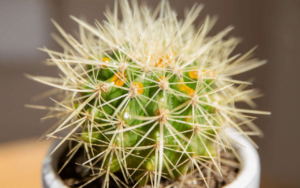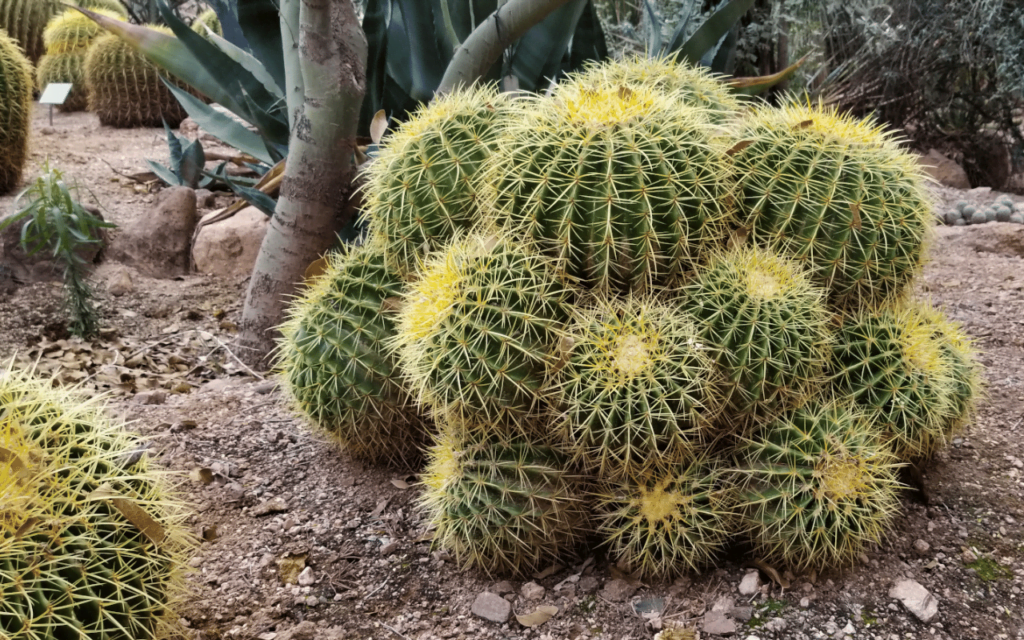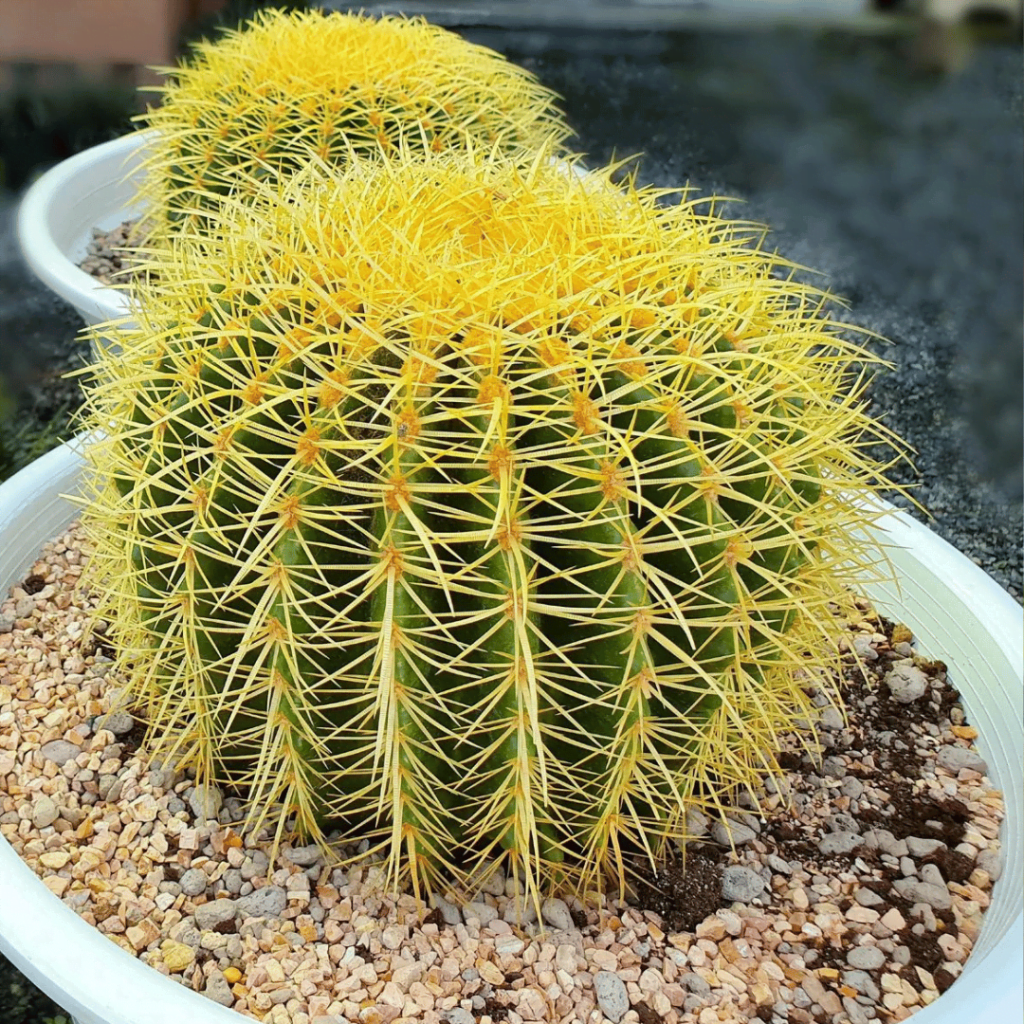Introduction
Indoor plants have often been a cherished addition to many households, providing a touch of nature to our urban settings. One of the most striking and unique additions is the Golden Barrel Cactus. This review aims to provide readers with a comprehensive understanding of caring for this fascinating specimen, ensuring it remains a vibrant and healthy centerpiece in your home.
Golden Barrel Cactus Indoor Plant Details
| Specification | Details |
|---|---|
| Common Names | Golden Barrel Cactus, Mother-in-law’s cushion |
| Botanical Name | Echinocactus grusonii |
| Family | Cactaceae (Cactus family) |
| Plant Type | Succulent |
| Mature Size | Up to 2-3 feet in height and 2-3 feet in diameter indoors; can grow larger in its native habitat |
| Sun Exposure | Full sun, partial shade indoors near a south or west-facing window |
| Soil Type | Well-draining cactus or succulent mix |
| Soil pH | 6.0 to 7.5 (slightly acidic to neutral) |
| Bloom Time | Late spring to early summer (mature plants) |
| Flower Color | Bright yellow |
| Hardiness Zones | 9-11 (typically grown indoors outside these zones) |
| Native Area | Central Mexico |
| Benefit | Aesthetically pleasing, low maintenance, air purifying qualities, adds a unique touch to indoor gardens |
Plant Care
The Golden Barrel Cactus, scientifically known as Echinocactus grusonii, is a low-maintenance plant, making it a favorite among both novice and experienced plant enthusiasts. However, even with its hardy nature, understanding its specific care requirements ensures its longevity and optimum growth.
Light
Sunlight is the primary energy source for plants, and the Golden Barrel Cactus is no exception. It thrives best under full sunlight. When placed indoors, ensure it’s close to a south or west-facing window where it can soak up ample sunlight. If you notice the plant becoming discolored or elongated, it might be an indication of insufficient light.
Soil
This cactus is native to arid regions, which means it has evolved to grow in well-draining soils. For indoor cultivation, a cactus or succulent potting mix is ideal. You can also make your own mixture by blending regular potting soil with perlite or sand. Ensuring good drainage is key to avoiding root rot – a common ailment in cacti.
Water
Watering is a delicate balance. While the Golden Barrel Cactus is drought-tolerant, it’s essential not to neglect its hydration needs. During its growth season, typically from spring to fall, water it once the top inch of the soil feels dry. In the dormant winter months, reduce watering frequency. Always avoid over-watering as this can lead to root rot.
Temperature and Humidity
Being a desert plant, the Golden Barrel Cactus prefers warmer temperatures. During the day, temperatures between 70°F to 100°F are ideal. At night, it can tolerate a drop down to 50°F. Humidity levels should remain low. In excessively humid environments, consider using a dehumidifier or placing the plant in a well-ventilated area.
Fertilizer
To boost its growth, you can feed the cactus with a diluted cactus fertilizer during the growing season. It’s essential to avoid over-fertilizing; doing it once every 4-6 weeks is sufficient. During its dormant period in the winter, refrain from fertilizing.
Pruning
Unlike other houseplants, the Golden Barrel Cactus doesn’t require regular pruning. However, you might occasionally need to remove dead or damaged spines or offsets. Always use protective gloves to avoid pricks and ensure you’re using sanitized tools to avoid transmitting diseases.
Overwintering
Winter care is crucial. As a dormant period for the cactus, it requires lesser water and no fertilizer. If temperatures in your area drop below 50°F, consider bringing the cactus indoors or providing it with some protective covering.
Propagating Plant
Propagation is a delightful way to multiply your cactus collection. The Golden Barrel Cactus can be propagated using offsets, which are the baby cacti that grow at its base. Gently remove them, allow them to dry for a couple of days, and then plant in a well-draining soil mix.
Types of Plant
While the Echinocactus grusonii or Golden Barrel Cactus is the most popular member of its genus, several types of barrel cacti thrive in various environments. A few notable species include:
- Echinocactus platyacanthus: Also known as the Giant Barrel Cactus, it’s larger and possesses a blue-green hue.
- Echinocactus horizonthalonius: This one has a slightly elongated shape with deep ribs.
- Echinocactus texensis: Commonly known as the Horse Crippler, it has a flatter and wider appearance.
Each type has unique characteristics, but they all share a love for sun, well-draining soil, and minimal water.
Common Pests & Plant Diseases with Solution
Barrel cacti, despite their prickly exterior, can sometimes fall victim to pests and diseases.
- Mealybugs: These are small, white, cottony pests that suck the sap from the cactus. Solution: Remove with a soft brush or isopropyl alcohol. In severe cases, consider using insecticidal soap.
- Spider Mites: These tiny pests are harder to spot but can cause a stippling appearance on your cactus. Solution: Increase humidity or use neem oil as a preventative measure.
- Root Rot: Over-watering can cause fungal diseases in the root. Solution: Ensure proper drainage. If the problem persists, consider repotting the plant in fresh, well-draining soil.
How to Get Plant to Bloom
A mature Golden Barrel Cactus can produce vibrant yellow flowers on its crown. To encourage blooming:
- Sunlight: Ensure it receives ample sunlight, as this can stimulate flowering.
- Watering: Maintain a consistent watering routine but avoid over-watering.
- Fertilization: Use a low-nitrogen cactus fertilizer during the growing season.
- Temperature: A slight temperature drop in the night compared to day can also promote blooming.
Common Problems With Plant
A few common issues that gardeners might face include:
- Discoloration: A sign of either too much sunlight or not enough. Adjust its location accordingly.
- Soft or Mushy Base: This is indicative of root rot. Check your watering routine and soil drainage.
- No Growth: If the cactus seems stunted, it might need repotting or fertilization.
- No Blooms: Ensure you’re meeting all the blooming conditions mentioned above.
Understanding the different types of barrel cacti, recognizing and solving common pest problems, stimulating bloom, and addressing common issues ensures your Golden Barrel Cactus thrives. This plant, with its distinctive appearance and easy care, can be a delightful addition to any indoor space when tended with knowledge and love.
Quickly Declining
While the Golden Barrel Cactus is sturdy, it’s not immune to issues. Root rot due to over-watering, insufficient light, or pests like mealybugs can hinder its growth. Regularly inspect your plant and adjust care routines as needed.
Flourishing Finale
In conclusion, the Golden Barrel Cactus, with its radiant charm, is an excellent addition to any household or office setting. By adhering to the care guidelines mentioned above, you can ensure it not only survives but thrives, offering you a beautiful and resilient green companion.
Golden Barrel Cactus tolerate full sunlight
The Golden Barrel Cactus, with its spherical shape and ribbed surface studded with golden-yellow spines, is a real sun worshipper. It flourishes under the relentless embrace of the sun’s rays, much like a desert nomad basking in the endless dunes. This cactus is a solar panel of the plant world; the more sunlight it absorbs, the more vibrantly it displays its golden hues. For best results, treat it to a daily sunbath—a minimum of 6 hours of direct sunlight is its bliss. When grown inside, consider placing it by a window that invites the afternoon sun or under a dedicated grow light to mimic its natural, sun-soaked habitat. This approach not only maximizes its growth potential but also enhances its bold, eye-catching appearance
Frequently Asked Questions
Decode the magic of gardens with our guide to Landscaping Styles Frequently Asked Questions.
- Repotting every 2-3 years is ideal, as this allows the cactus to have fresh soil and more space to grow.
- Absolutely! This cactus thrives under full sunlight. However, gradual acclimatization is essential if it’s been in a shaded area for a long time.
- While not toxic, its spines can be harmful. It’s best to place it in an area inaccessible to pets.
This could be due to natural aging or over-watering. Ensure proper watering routines and inspect for any signs of root rot.
Recent Posts
- Modern Mural Ideas Transforming Walls into Artworks
- Thematic Table Decor Dressing Your Table for Special Occasions
- Festive Lighting Ideas Brightening Your Home for the Holidays
- Biodegradable Decor Materials Choosing Earth-Friendly Options
- Personalized Space Decor Making Your Home Uniquely Yours
- New Year’s Eve Decor Ringing in the New Year in Style
- Transforming Junk into Decor Upcycling at Its Best
- Second-Life Decor Objects Giving Old Items New Purpose
- Unique Decoration Crafting Standout Ideas for Your Home
- Environmentally Friendly Styling Decor with a Conscience











